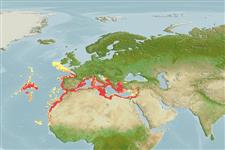Environment: milieu / climate zone / depth range / distribution range
Ecología
marino demersal; rango de profundidad 51 - 1456 m (Ref. 104125). Subtropical; 53°N - 15°N
Eastern Atlantic: southern England to Senegal and the northern Mediterranean.
Tamaño / Peso / Age
Maturity: Lm ? range ? - ? cm
Max length : 25.4 cm TL macho / no sexado; (Ref. 59104); peso máximo publicado: 39.00 g (Ref. 86713)
Uncommon species (Ref. 34024). Oviparous, with oval pelagic eggs floating in a gelatinous mass (Ref. 205). Minimum depth from Ref. 122785.
Life cycle and mating behavior
Madurez | Reproducción | Puesta | Huevos | Fecundidad | Larva
Nielsen, J.G., D.M. Cohen, D.F. Markle and C.R. Robins, 1999. Ophidiiform fishes of the world (Order Ophidiiformes). An annotated and illustrated catalogue of pearlfishes, cusk-eels, brotulas and other ophidiiform fishes known to date. FAO Fish. Synop. 125(18):178p. Rome: FAO. (Ref. 34024)
IUCN Red List Status (Ref. 130435: Version 2024-1)
Threat to humans
Harmless
Human uses
Pesquerías: sin interés
Herramientas
Special reports
Download XML
Fuentes de Internet
Estimates based on models
Preferred temperature (Ref.
123201): 11 - 14.5, mean 13.8 °C (based on 179 cells).
Phylogenetic diversity index (Ref.
82804): PD
50 = 0.5000 [Uniqueness, from 0.5 = low to 2.0 = high].
Bayesian length-weight: a=0.00275 (0.00168 - 0.00450), b=3.17 (3.03 - 3.31), in cm total length, based on LWR estimates for this species & (Sub)family-body (Ref.
93245).
Nivel trófico (Ref.
69278): 3.6 ±0.0 se; based on diet studies.
Resiliencia (Ref.
120179): Alto, población duplicada en un tiempo mínimo inferior a 15 meses (Preliminary K or Fecundity.).
Fishing Vulnerability (Ref.
59153): Low vulnerability (15 of 100).
Nutrients (Ref.
124155): Calcium = 70.7 [16.3, 209.0] mg/100g; Iron = 1.17 [0.40, 4.43] mg/100g; Protein = 16.8 [14.2, 19.4] %; Omega3 = 0.394 [0.161, 0.967] g/100g; Selenium = 34.1 [7.2, 102.1] μg/100g; VitaminA = 13.3 [4.0, 42.6] μg/100g; Zinc = 0.743 [0.391, 1.486] mg/100g (wet weight);
